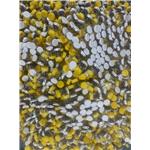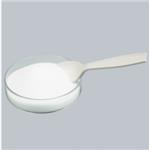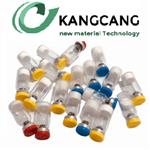- Botulinum toxin
-

- $50.00 / 1box
-
2024-04-30
- CAS:93384-43-1
- Min. Order: 1box
- Purity: 99.99%
- Supply Ability: 1000
- BOTULINUM TOXIN A
-

- $268.00 / 10kg
-
2024-04-30
- CAS:93384-43-1
- Min. Order: 10kg
- Purity: 99.99%
- Supply Ability: 100Tons
- Botulinum toxin
-

- $100.00 / 1box
-
2024-04-30
- CAS:93384-43-1
- Min. Order: 1box
- Purity: 98%
- Supply Ability: 20ton
Related articles - Use of Botulism
- Botulism, a disease of the nervous system in animals and humans, was first recorded in Germany in 1735 and was thought to be d....
- Nov 29,2021
|
| | BOTULINUM TOXIN A Basic information |
| | BOTULINUM TOXIN A Chemical Properties |
| storage temp. | −20°C | | form | lyophilized powder |
| | BOTULINUM TOXIN A Usage And Synthesis |
| Description | Botulism, a disease of the nervous system in animals and
humans, was first recorded in Germany in 1735 and was
thought to be due to eating a tainted sausage. The name
botulism comes from the German ‘botulus’ for sausage. Botulinum
toxin (molecular weight of 100 000, consisting of 1300
amino acids) is derived from Clostridium botulinum – an
anaerobic spore-forming gram-positive bacterium commonly
found in soil. It can affect a wide range of animals, including
mammals, fish, and birds. There are seven serological varieties
of botulism denoted by the letters A–G. They are structurally
similar but antigenically and serologically unique. Only the
botulism types A, B, E, and F can cause toxicity in humans.
Types C and D can cause toxicity in animals. From 1990 to
2000, the US Centers for Disease Control documented 263
individual cases from 160 foodborne botulism events in the
United States; 4% of these resulted in fatality and 103 of these
cases occurred in Alaska. They were due to traditional Alaska
aboriginal foods, including the ingestion of raw whale fat or
muktuk. While the numbers of cases of foodborne botulism and
infant botulism are stable, the incidence of wound botulism
has increased due to the use of black tar heroin. California has
reported the majority of cases of wound botulism associated
with tar heroin use. | | Uses | The use of botulinum toxin includes medicinal (e.g., treatment
of spastic conditions, hyperhidrosis), cosmetic (removal
of wrinkles), or as a potential terrorism agent (e.g., via
aerosolization). | | Indications | Botulinum toxin purified neurotoxin complex (Botox) is a
purified form of botulinum toxin type A, produced from a
culture of Clostridium botulinum. Injection of botulinum
toxin into muscle induces paralysis by inhibiting the release
of acetylcholine from motor neurons, thereby blocking
neuromuscular conduction. It is approved for the
treatment of blepharospasm, strabismus, and excessive
sweating. Botox is also approved for use in dermatology
to induce paralysis of the muscles of facial expression to
reverse deep wrinkles. The effect of an individual treatment
usually becomes apparent within 3 days and lasts
approximately 3 months. The effect may persist for a
longer period after a series of treatments because the
muscles atrophy. The major adverse effect is temporary
loss of function of a muscle required for normal social
functioning, as may occur after inadvertent injection of
muscles required for smiling or raising the upper eyelids. | | Biological Functions | Botulism is most commonly caused by ingestion of a
neurotoxin produced by Clostridium botulinum in improperly
canned food. Poisoning may also occur after
wound contamination with the organism. Infant botulism
may occur when spores of the organism germinate
and manufacture the toxin in the intestinal tract of infants.
Botulinum toxin works by inhibiting ACh release
at all cholinergic synapses.
Botulinum toxins are classified into seven antigenically
distinct types, A through G. Each consists of a
polypeptide chain of about 150,000 daltons. All but one
is nicked by trypsin-type enzymes to yield a light and
heavy chain linked by a disulfide bridge.One end of the
heavy chain mediates binding to the nerve terminal, and
the other initiates internalization of the toxin. The light
chain produces the intracellular inhibition of ACh release.
This involves a Zn��-dependent endopeptidase
action to cleave synaptic target proteins that control
vesicle docking and fusion with the prejunctional membrane. | | Clinical Use | Botulinum toxin is used clinically in the treatment of
blepharospasm, writer’s cramp, spasticities of various
origins, and rigidity due to extrapyramidal disorders. It
is also used to treat gustatory sweating and cosmetically
to decrease facial wrinkles. Botulinum toxin A (Botox,
Oculinum) injected intramuscularly produces functional
denervation that lasts about 3 months. Clinical
benefit is seen within 1 to 3 days.Adverse effects range
from diplopia and irritation with blepharospasm to
muscle weakness with dystonias. | | Side effects | Botulinum toxin is the most toxic substance known.
One gram of crystalline toxin adequately dispersed can
kill a population of a million people, so its use in bioterrorism
is a possibility. The toxin can be introduced
through inhalation or ingestion but not through dermal exposure. The threat of mass inhalation poisoning is
limited by the ability or inability to aerosolize the toxin
for widespread dispersion. Contaminating the water or
food supply is also a possibility, although the toxin is
degraded by standard water treatment and by heating
of foods to 85°C (185°F) for 5 minutes. Prior immunization
with toxoid vaccine is advisable for personnel at
risk, but prophylactic administration of trivalent equine
antitoxin is not recommended. | | Environmental Fate | Clostridium botulinum secretes an exotoxin (of which there are
seven distinctive antigenic types labeled A–G) consisting of
proteinaceous heavy and light chains linked together by
a disulfide bond. Human poisonings have predominantly
been due to types A (vegetables), B (meat), and E (fish). The
toxin inhibits acetylcholine-mediated neurotransmitter
release by binding onto SNARE proteins that facilitate
exocytosis of acetylcholine synaptosomes. The heavy chain
directs endocytosis of the toxin into a neuron in the peripheral
nervous system. The pharmacologically active zincdependent
endopeptidase light chain then binds to the
SNARE proteins (synaptobrevin, SNAP-25, syntaxin), cleaving
a portion of the protein and thus destroying it. The consequence
is blockage of acetylcholine release. The toxin does not
cross the blood–brain barrier and affects only peripheral
motor nerves. | | Toxicity evaluation | Inadequately sterilized processed products (e.g., canned foods)
can be contaminated with neurotoxin-producing spores,
leading to potential accidental exposure by ingestion (the most
common route). Poor food hygiene during food preparation
has been the major causes of large outbreaks of foodborne botulism. In patients with underdeveloped intrinsic gut
immunity (e.g., infants), C. botulinum colonization of the
gastrointestinal tract can occur. Susceptibility to colonization
can also occur where the normal gastrointestinal protective
mechanisms are deficient (e.g., in patients who have undergone
major gastric surgery whereby acid production is reduced or
where bile acid formation has ceased).
Cutaneous absorption and thus toxicity do not occur if the
skin is undamaged. However, an open wound or mucous
membrane exposed to the bacterium increases the risk of
toxicity. |
| | BOTULINUM TOXIN A Preparation Products And Raw materials |
|